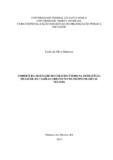| dc.contributor.advisor | Cabral, Fernanda Beheregaray | |
| dc.creator | Gutteres, Carla da Silva | |
| dc.date.accessioned | 2020-03-02T14:50:32Z | |
| dc.date.available | 2020-03-02T14:50:32Z | |
| dc.date.issued | 2015-12-05 | |
| dc.date.submitted | 2015 | |
| dc.identifier.uri | http://repositorio.ufsm.br/handle/1/19688 | |
| dc.description | Artigo (especialização) - Universidade Federal de Santa Maria, Campus de Palmeira das Missões, Curso de Especialização em Gestão de Organização Pública em Saúde, EaD, RS, 2015. | por |
| dc.description.abstract | Objective: To determine the coverage of the examination of the cervix in the Urban Family Health Strategy - ESF 3 in the municipality of Erval Seco / RS occurred during the period 2012-2014. Method: This is a descriptive, documentary and retrospective study with a quantitative approach. The research was conducted in the Urban Family Health Strategy in the city of Herbal Seco / RS. The variables included in the study were age, date of collection and Pap result. Data were collected in the Register and Women Undergoing Tracking the Cervical Pap test available in the service and analyzed using descriptive statistics, after presented by means of tables showing the frequency of the data. Results: Achieving coverage of Pap smear in the studied FHT had highest percentage among women aged 40 to 59 years during the three years, so at the age of greatest risk we observed the high demand by women. It was found that the results did not have cytological abnormalities, being the most negative. Conclusions: The realization of the Pap test is a safe and effective strategy for early detection of cervical cancer. Through this research we realized the importance of prevention of cervical cancer programs, so it is necessary arrangements to increase the coverage of screening and the search for the exam, we need to prevent and diagnose cancer as early as possible. | eng |
| dc.language | por | por |
| dc.publisher | Universidade Federal de Santa Maria | por |
| dc.rights | Acesso Aberto | por |
| dc.rights | Attribution-NonCommercial-NoDerivatives 4.0 International | * |
| dc.rights.uri | http://creativecommons.org/licenses/by-nc-nd/4.0/ | * |
| dc.subject | Saúde da mulher | por |
| dc.subject | Exame citopatológico | por |
| dc.subject | Câncer de colo uterino | por |
| dc.subject | Women's health | eng |
| dc.subject | Pap smear | eng |
| dc.subject | Cervical cancer | eng |
| dc.title | Cobertura do exame do colo do útero na estratégia de saúde da família urbano no município de Erval Seco/RS | por |
| dc.title.alternative | Coverage of cervical examination in urban family health strategy in Erval Seco/RS | eng |
| dc.type | Trabalho de Conclusão de Curso de Especialização | por |
| dc.degree.local | Polo de Palmeira das Missões, RS, Brasil | por |
| dc.degree.specialization | Gestão de Organização Pública em Saúde, EaD | por |
| dc.description.resumo | Objetivo: Verificar a cobertura do exame do colo do útero na Estratégia de Saúde da Família Urbano – ESF 3 no município de Erval Seco/RS ocorridos durante o período de 2012 a 2014. Método: Trata-se de um estudo descritivo, documental e retrospectivo com abordagem quantitativa. A pesquisa foi desenvolvida na Estratégia de Saúde da Família Urbano no Município de Erval Seco/RS. As variáveis incluídas no estudo foram idade, data da coleta e resultado citopatológico. Os dados foram coletados no Livro de Registro e Seguimento de Mulheres Submetidas ao Exame Citopatológico do Colo do Útero disponível no serviço e analisado por meio de estatística descritiva, após apresentados por meio de tabelas que mostram a frequência dos dados. Resultados: A cobertura de realização do exame Papanicolau na ESF pesquisada teve maior percentual entre mulheres na faixa etária dos 40 aos 59 anos no decorrer dos três anos, portanto na faixa etária de maior risco observamos a alta procura pelas mulheres. Verificou-se que os resultados citopatológicos não possuem anormalidades, sendo a grande maioria negativo. Conclusões: A realização do exame de Papanicolau é uma estratégia segura e eficiente para a detecção precoce do câncer do colo do útero. Através dessa pesquisa percebemos a importância dos programas de prevenção do câncer de colo uterino, por isso, se faz necessário medidas para que se aumentem a cobertura do rastreamento e a procura para realização do exame, é preciso prevenir e diagnosticar o câncer o mais cedo possível. | por |
| dc.publisher.country | Brasil | por |
| dc.publisher.initials | UFSM | por |
| dc.subject.cnpq | CNPQ::CIENCIAS DA SAUDE::SAUDE COLETIVA::SAUDE PUBLICA | por |
| dc.publisher.unidade | Centro de Ciências Sociais e Humanas | por |



